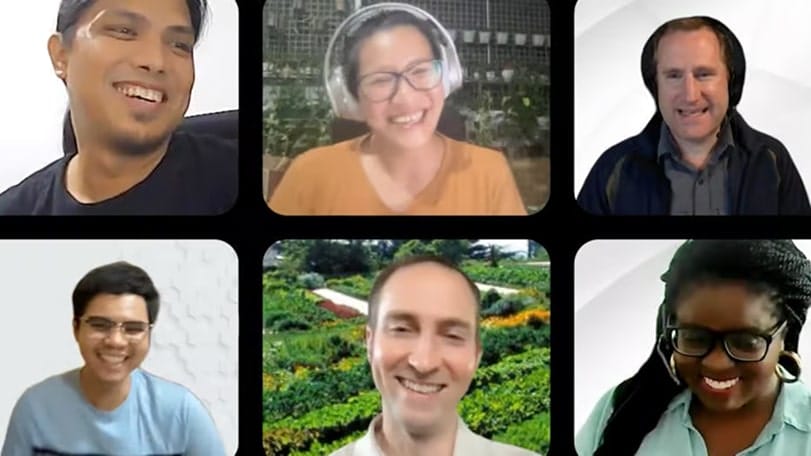Winning Knowbility’s Accessibility Internet Rally 2022

What Is the Accessibility Internet Rally?
The Accessibility Internet Rally (AIR) is an international competition hosted by Knowbility. It challenges web professionals to design and build fully accessible websites for nonprofit organizations. Teams receive accessibility training, work closely with a real client, and have eight weeks to deliver a site that meets strict accessibility standards while providing a great user experience.
In late 2022, three members of our Desert Wing Design team, Gerson, Graham, and Kosi, joined four other accessibility advocates from around the world to take on that challenge. Together we formed a team and named it AirWay. The name was chosen not only to connect with Knowbility’s “AIR” competition acronym, but also to reflect the idea of following a clear path to a destination, just like aircraft navigating across country. We wanted to fly high and deliver on our commitment to create an accessible website for a worthy recipient.
AirWay was matched with Work Opportunities, a nonprofit dedicated to helping people with disabilities find and keep meaningful employment. Guided by mentor Sindhuja “Cindy” Xavier, a senior accessibility product manager at Amazon and veteran of several AIR competitions, we set out to transform the organization’s website into a more engaging, user-friendly, and fully accessible resource for the community it serves.
Meet the AirWay Team
Every member of AirWay brought unique skills and perspective to the project. Together, we made accessibility our mission.
- Graham Venning – Team lead who kept the project moving with steady leadership and positive energy.
- Gerson Lacdao – Developer who combined technical expertise with empathy, shaped by his nursing background.
- Kosi Asabere – Quality assurance tester and trainer whose deep knowledge of accessibility guidelines made the site both compliant and inclusive.
- Patrick Gerolaga – Project manager who kept workflows organized and deadlines on track.
- Deneb Pulsipher – Developer who brought precision and creativity to the site’s structure and functionality.
- Catt Juan – UX designer who made the site visually appealing and intuitive for people of all abilities.
- Sindhuja “Cindy” Xavier – Mentor whose expert guidance and encouragement helped us make smart decisions every step of the way.
📺 Watch our introduction video.
The Challenge
The original Work Opportunities website was functional but text-heavy and difficult to navigate. Our mission was to redesign it into a site that was visually engaging, easy to use, and fully accessible.
Before and After:


The new design included visuals, icons, gradients, and a welcome video, all carefully built to meet accessibility standards. We ran accessibility checks, remediated issues, and ensured the final product worked seamlessly for everyone.
The result was a transformation. The Work Opportunities website became more than an information hub. It became a welcoming, accessible space that reflects the organization’s mission and values.
Building Accessibility Into Every Step
Accessibility has been at the heart of AIR since its beginning in 1998, one year before the first Web Content Accessibility Guidelines (WCAG) were released. What started as a way to help nonprofits gain accessible websites has grown into a global learning experience for thousands of developers and designers.
For Work Opportunities, we focused on making the site welcoming to everyone they serve. The organization needed to speak to four groups: job seekers with disabilities, community employers, parents and guardians, and donors. We redesigned the site so each group could quickly find information relevant to them, instead of being overwhelmed by long blocks of text.
We also introduced new ways for Work Opportunities to share their story. A custom feature allowed staff to collect and publish client stories in multiple formats—written, audio, or video—with transcripts and captions to make sure no one was left out. The homepage video was also supported with an audio-described version and a full transcript, giving visitors different ways to experience the same message.
Behind the scenes, we built the site with semantic HTML, reviewed ARIA attributes, and tested it across multiple screen readers including JAWS, NVDA, and VoiceOver. This process helped ensure consistency, even when assistive technologies behaved differently. These steps reminded us that accessibility is not a final checklist, but something to be built into every stage of the process.
As part of the competition, Knowbility provided every team with one hour of Guided Usability Testing using a blind participant and native screen reader user. We developed a detailed test plan to make the most of the 60-minute session. During testing, the participant navigated the site with JAWS, explored employment resources, and interacted with videos and organizational content. The feedback highlighted the site’s intuitive navigation, clear labeling, and the absence of disruptive content. These insights reinforced the value of designing with lived experience at the center and reminded us that accessibility removes barriers and opens doors for the people organizations serve.
Volunteering Our Time
Our combined team of six recorded nearly 600 volunteer hours, not only building the site but also training Work Opportunities staff to make the most of their new WordPress website.
Thanks to employer donation matches, those volunteer hours turned into another win: $36,000 was donated back to Knowbility, helping the nonprofit continue its mission of advancing digital accessibility worldwide.
A Global Learning Experience
Another unique aspect of the project was the chance to collaborate with a leading British university conducting research on how accessibility skills are taught and developed. As part of their multi-year study, a researcher joined several of our online meetings and later invited team members to share reflections through interviews and focus groups.
This partnership gave us the opportunity to contribute to international research on accessibility education while deepening our own learning through reflection and dialogue. It also underscored how AIR brings people together across borders, uniting nonprofits, industry professionals, and higher education in a shared mission of inclusion. We hope the insights shared from our experience will help shape the way accessibility is taught to future designers, developers, and organizations worldwide.
Waiting for the Results
After submission, we had to wait forty-two long days. We knew we had created something meaningful, but competition was tough.
When the results were finally announced in January 2023, it was worth the wait: AirWay won.
📖 Read Knowbility’s official announcement.
More Than a Win
Winning was exciting, but the true reward was knowing the project made a difference for both the nonprofit and the people it serves.
For Desert Wing Design, the AIR competition deepened our commitment to accessibility, not just as a best practice but as a responsibility. Every website should work for every person. This experience reinforced why that matters.
How It Shapes Our Work Today
What we learned through AIR continues to guide how we serve our clients. At Desert Wing Design, accessibility is not an afterthought. It is built into every stage of our process, from discovery and design to development, testing, and launch. The lessons of teamwork, empathy, and accountability from AirWay now shape the way we partner with organizations, helping them create websites that welcome every visitor and reflect their values.
If your organization is ready for a website that puts accessibility first, let’s start the conversation.
